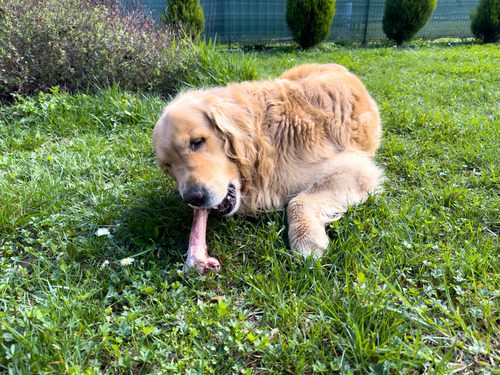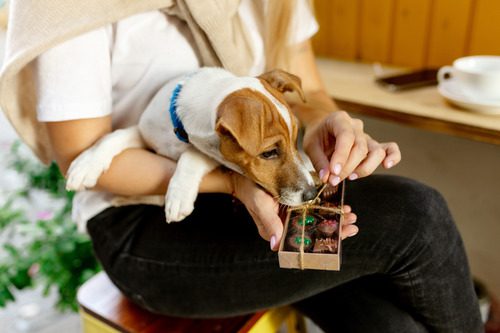My Dog Was Stung by a Bee, What Do I Do?
Has your dog been stung by a bee, a wasp, or another stinging insect? If your dog is experiencing pain, swelling, and other symptoms associated with an insect sting, it’s important to know how to respond. Keep in mind, however, that insect stings are different than bites, so you need to determine which one your dog is dealing with first.

From there, you can follow the directions in the guide listed below. This information can help you stay calm and react properly if your pet is stung, and it can help you learn when to see an emergency vet, too.
6 Things You Should Do if Your Dog is Stung by a Bee
If you see your dog get stung by a bee, or if you notice a stinger in your pet, it’s important to know what actions you should take in order to make sure your pet gets the proper care they need.
Below are 6 things you should do when your dog gets stung by a bee:
1. Remove the Stinger
You’ll first need to locate the sting and part your dog’s hair to get to the site. You will probably need the help of another capable adult or older teen, as it’s likely your dog will be upset and in pain through this process. Dr. George Melillo, Founder and Chief Veterinary Officer of Heart + Paw, also says that, “Having someone to help restrain your dog will help avoid any accidental bites.”
With one person holding and calming the dog, use sharp tweezers to gently grasp and pry out the stinger. Try to get it all in one pass, but double-check to make sure part of it hasn’t broken off and remained inside your dog’s skin after your first attempt at removing it.
2. Treat the Sting
With the stinger fully removed, you will need to treat the bee sting itself. Mix up some baking soda and water until it forms a sticky paste-like substance, and then apply this to the location of the sting. This will help take down the pain and swelling as well as reduce the other symptoms of the insect sting.
Try to keep your dog from licking this paste off for several minutes. If your dog does lick some of it, however, it won’t hurt them, although it will prevent the paste from being as effective.
3. Treat the Swelling
The next thing you’ll need to do if your dog is stung by a bee is to treat the swelling caused by the sting. Use an ice pack on the location of the sting to help take down this swelling and reduce the pain at the same time. Make sure to wrap the ice pack in a towel or washcloth so it doesn’t hurt your dog’s skin.
If your dog is very uncomfortable, you might find it difficult to get them to sit still while you apply the ice pack. It may be better to avoid stressing them further, so take time to gauge the situation before using an ice pack on your pet.
4. Call the Regular Vet
Now that you’ve gotten the stinger out, contact your regular veterinarian to find out if your dog needs medication. Some vets may instruct you to give your dog Benadryl or Tylenol; however, you should absolutely never give your dog human medications like these without the express direction of your vet.
Your vet can tell you how much and what types of medication to give your pet, and will also let you know if you should avoid giving your pet any human medicine at all. The vet may also ask you for a rundown of your pet’s symptoms to make sure they don’t need to be seen.
5. Provide Water
If your dog got stung by a bee, they may have gotten very panicked or may be in pain. They may also run a low fever as a result of the sting. All of these factors can contribute to mild dehydration, so it’s important to provide plenty of fresh, cool, clean water for your dog to drink after they’ve been stung by an insect.
Although it may be tempting to give them some treats to help them calm down, it’s best to hold off on any food for a couple of hours. This way, their body can work on recovering from the sting without risking additional stomach upset.
6. Monitor Your Dog Closely
Now that your dog has had a chance to relax and start recovering, you need to keep an eye on them to see whether or not they’re going to suffer from a more serious allergic reaction. This type of reaction is uncommon in dogs, but it isn’t impossible.
Monitor your dog closely for the next day to make sure they don’t show any signs of the situation worsening. If not, they should be in the clear.
Make Sure to Respond Right Away if Your Dog is Stung By a Bee
Many times, dogs will recover fully from being stung by a bee or wasp and won’t need any type of vet care to help them heal. However, in some instances, dogs may be very allergic to these stings. Dogs who have severe insect allergies are at risk of anaphylaxis when they are stung, and this can be a life-threatening situation.
If you know your dog is severely allergic to insect stings, or if you suspect they are dealing with a moderate to severe anaphylactic reaction, take them to the emergency vet right away. Signs of anaphylaxis include swelling of the face and throat, increased heart rate, and severe panting.
It’s not uncommon for dogs to love to play outside, especially during the times of year when the weather is nice. This are usually the times of year when bees become more prominent, as well. If your dog gets stung by a bee and you’re not sure if they need veterinary care, contact our team at Heart + Paw today. You can book an appointment online or call any of our locations to set up a wellness appointment for your pet.
Recent Posts
Can Dogs Eat Ham?
Ham is a popular meat found on many dinner tables, especially during the holidays. As a dog…
8 Signs and Symptoms of Diabetes in Dogs
Caring for a dog means being tuned in to the subtle changes that can reveal their overall…
Why Dogs Can’t Eat Chocolate and Tips for Keeping This Sweet Treat Out of Their Reach
Chocolate is a beloved indulgence for us, but for our dogs, it’s a hidden danger that can…
Why Cat Teeth Cleaning is Important For Your Pet’s Health
As a cat owner, you know how important it is to care for your feline friend’s overall…
Cat Body Language: A Guide To Understand What Your Cat is Telling You
Imagine trying to communicate without words, relying solely on subtle gestures, glances, and movements. This is how…
About Us
Heart + Paw was founded in 2018 by Chief Veterinary Officer Dr. George Melillo, who currently serves the Mid-Atlantic area. Heart + Paw offers a combination of veterinary care, pet grooming, and dog daycare to help be a resource in your pet parenthood journey.
We'd Love to Meet Your Four-Legged Friends
Find out how the friendly veterinary team at your local Heart + Paw can help your pets live longer, healthier lives by searching for a location near you.





